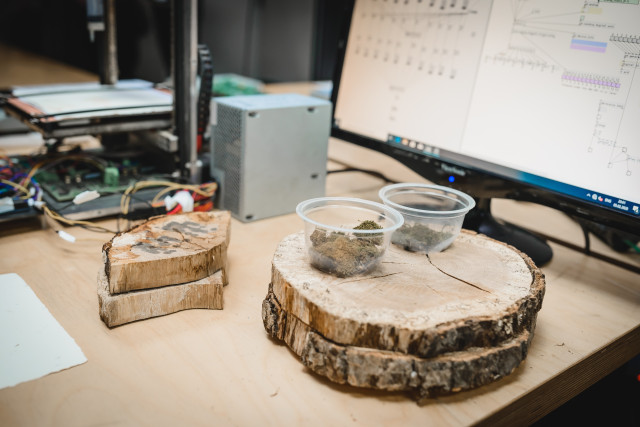Memory Moss
- Date
- December 2020
- Website
- https://www.lukuta.art/memory-moss
Memory Moss is a hypothesis of encoding the humane information into a biological organism in order to transfer it to an organic natural agent.
A 3D matrix printer extrudes information on a decomposable organic carrier (wood, paper, etc.). Left in nature, the encoded moss transforms itself and is absorbed by it.
The object itself becomes an interface that can allow transferring the information between two systems living in different temporalities. The hypothesis brings up a question of the possibility to send data to organic systems that percept time and information in a way that is different from humans. The printer and carrier combined to become a prismatic interface that equalizes the accessibility of original data in such a way that it could be consumed by an agent with a different temporality.
The issue of decoding the information is not viewed in the project as the main research focus is about translating it to another subject that has different temporal and receptoral perception.
The data formats for the printing machine can be of various origins: it may be an image (or an image sequence) or a simple text string that is encoded bit-per-bit to the organic carrier.
The information is first encoded into ASCII and then to binary code. The code is extruded on a matrix printing machine.
The information is encoded by moss mixed with the nutrient medium, which itself is put on a nutrient carrier (wood or paper), making it possible for its further growth and interaction with the ultimate recipient of information - nature.
While working on the project, a study was conducted on what types of mosses exist in the Primorsky Territory, namely in the surroundings of Vladivostok. Several types of compositions for printing on a printer were also tested, and then analysis was carried out to determine which ones are most suitable. The basis for the "biological ink" was kefir, as the most nutrient environment for the growth of moss.
In addition, we studied the theoretical base on the topic of new ontologies, such books as Con Eduardo’s “How Forests Think. To Anthropology on the Other Side of Man ”, Anna Lövenhaupt Jing’s “Mushroom at the End of the World ”, Alexander Pshera’s “Internet of Animals”, Megumi Oshima and Hideshi Kimura’s “Miniature Moss Gardens”, Robin Wall Kimmerer’s “Gathering Moss: A Natural and Cultural History of Mosses".
CREDITS
Project by Timofey Gorbatenko, Julia Kozhurina, Ivan Kumets, Anastasia Lukuta
Led by Dmirtry Morozov
Made in Far Eastern Federal University, –Da. Master Program in Digital Art. School of Digital Economics.




